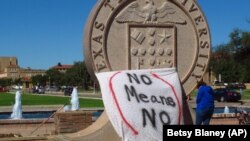As college students headed back to campus across the U.S. this fall, many encountered something new: mandatory workshops designed to prevent sexual abuse.
Faced with an increase of reported sexual assaults on college campuses, many U.S. universities launched programs aimed at promoting student awareness of sexual violence.
In Washington DC, George Washington University, American University and Georgetown University are just a few of the institutions implementing programs to provide students with tools to help prevent sexual assault and resources for victims.
The latest survey from the Association of American Universities found that 20 percent of students reported sexual assault last year alone. That has prompted universities to take steps to prevent such cases.
Robert D. Hradsky, Assistant Vice President of Campus Life at American University, says effective programs to prevent sexual violence must begin the moment students first arrive on campus for orientation.
“In the very first week, when students arrive on campus, they go through a 90-minute training [called] ‘Empower A.U.’ that also goes over issues around interpersonal sexual violence, consent, and myths around relationship violence,” said Hradsky.
“We try to give students the tools they need in particular to intervene when they see that someone might be in harm’s way”, he said.
Increase in sexual assaults
Over the last three years the number of reported incidents of sexual assault at American University increased, from 36 cases in 2012-13 to 61 in 2014-15.
In response, the school crafted clear standards for incidents of sexual assaults, and procedures for providing help to victims.
“The most immediate concern is ensuring the safety of the survivor,” Hradsky told VOA. “We want to make sure that the survivor understands all the resources, so that if they need medical care they know where they can receive it. If they are interested in collecting evidence in the event that they may want to pursue criminal charges, [they] understand how to do that and where to go, we help them get there,” he said.
Additionally, the university created a Sexual Assault Working Group, charged with reviewing university efforts on issues of interpersonal and sexual violence including sexual assault, dating, and domestic violence and stalking.
Hradsky says the group of 13 students takes part in decisions on how sexual assault cases are managed. “We are working very closely with all of students’ representatives to help to inform our approach and be a part of the solution,” he said.
Bringing abuse out in the open
Across town, George Washington University this fall mandated sexual assault prevention training for incoming freshmen and graduate students, followed by an online program later in the summer.
“Our strategy has been and will continue to be having a comprehensive, multifaceted approach to sexual assault awareness education,” said Dr. Konwerski, GWU Dean of Student Affairs in a press release published on university’s website. “This summer we will continue this approach with some new offerings.”
The program was first proposed by GW Students Against Sexual Assault (SASA), an association specifically formed to combat sexual assault.
Lauren Courtney studies political science and pre-law at GWU, and serves as director of Policy and Community Outrage at SASA. Courtney says the program features conversations about drinking alcohol, campus safety, living in a city, as well as sexual violence.
“The university really wanted to talk about mental health, making sure that students are safe and not drinking too much, but the university didn’t want to talk about sexual assault,” Courtney told VOA. “For a long time it just has been a norm for the university to pretend that sexual assault doesn’t happen on campuses because it’s a huge liability. A university’s worst nightmare is to have a scandal”, she said.
Data from the AAU study shows that more than 1 in 5 female undergrads at top schools reported suffering a sexual attack, but Courtney believes the real number is bigger. “I think that [sexual assault] always has been this big. People knew that it was going on and their studies showed that it was going on, but people were so discouraged from reporting”, Courtney added.
All university students who have experienced sexual assault have the right to report the abuse if they so choose. Once a report is made, a second of U.S. law called Title IX mandates that the school provide treatment.
“They have to find ways to help the survivors still function at the university,” said Lauren Courtney. “That could mean having a legal process at the university to try the student of sexual assault and after it convicted they could be suspended, forced to leave the university.”
Robert Hradsky pointed out that sexual violence is now on the public agenda, and that people are speaking more publicly because of the national visibility. Hradsky said years ago when he was in in school, people didn’t speak about sexual assault.
“That is absolutely a difference,” Hradsky said. “So, back then, you generally didn’t talk about it a whole lot. Now with all this national visibility, clearly it’s a part of the everyday conversation in campus.”
At American University, speaking about the problem of sexual assault is becoming more common – an important step to preventing it, says Hradsky. “It is better to show the problem than to pretend we do not see it, because it exists.”









